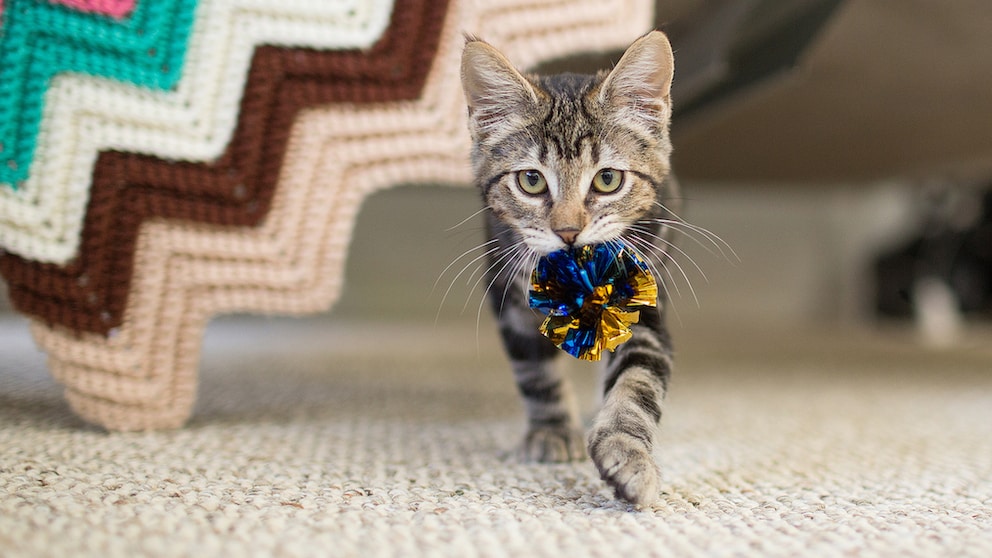September 5, 2024, 10:34 am | Read time: 4 minutes
Retrieving objects is a behavior that is more commonly associated with dogs. But cats also like to catch and retrieve their toys – even more often than previously thought. This was discovered by US researchers who surveyed more than 8,000 cat owners about their pets’ behavior.
Of the nine cats I’ve had the pleasure of keeping as pets throughout my life, only two could fetch toys. I believed this behavior wasn’t particularly common in cats. This assumption was challenged when US researchers discovered in a study that over 40 percent of cats occasionally or regularly retrieve items. This article will explore which breeds are particularly prone to this behavior and how it may have developed.
Why do cats fetch?
In terms of behavioral biology, retrieving in cats is classified as hunting behavior. For example, mother cats bring prey to their offspring by carrying it in their mouths. However, whether this behavior led to catching and retrieving toys is still unclear. In dogs, on the other hand, it is assumed that retrieving originates from hunting behavior. Breeding has also actively encouraged this over the years.
“During the domestication of dogs, we selected them for some specific behaviors, such as retrieving,” the science magazine “LiveScience” quotes Mikel Delgado, co-author of the study. This could explain why this behavior occurs much more frequently in dogs than cats.
Study also investigated retrieval behavior in dogs
For Delgado, the more pressing question is why a significant number of cats engage in fetching. This is intriguing because, unlike dogs, humans did not selectively breed cats for tasks like hunting or herding.
To shed more light on the subject, a team of scientists from Purdue University in Indiana analyzed online surveys of cat and dog owners between 2015 and 2023. These included asking owners about their pets’ retrieving behavior. The online journal “PLOS One” published the results.
Cats retrieve more often than previously assumed
Of the more than 8,000 cat owners who participated in the survey, 41% reported that their cats sometimes, regularly, or always retrieved toys or objects they had thrown. This means that the percentage of cats that retrieve is much higher than previously assumed, according to the researchers.
In comparison, of the almost 74,000 dog owners who participated in the online survey, 78 percent stated that their dogs exhibited retrieving behavior. In the case of dogs, it was primarily the animals considered to be particularly trainable in the evaluation of the survey that were reported to retrieve. However, in the case of cats, it was mainly those classified as active and playful.
These breeds retrieve particularly often
All cat breeds were reported to retrieve. However, the study found this was more common in Burmese, Siamese, and Tonkanese cats. In another study from 2023, in which three psychologists from Great Britain investigated the circumstances under which cats retrieve things, the behavior was also described primarily for Siamese cats (PETBOOK reported). But also for Bengal cats and Ragdolls. According to other studies, Siamese cats, Abyssinian cats, and Himalayan cats, in particular, are said to retrieve frequently.
According to the study, the following factors also increase the likelihood of cats retrieving:
- male
- pure domestic cat
- no health problems
On the other hand, living with dogs reduced the likelihood of cats displaying the behavior. The researchers suspect this could be because dogs display predatory behavior towards cats or their toys.
Did retrieving evolve from play behavior?
This study is groundbreaking in its investigation of the frequency with which cats—and dogs—retrieve objects. Although the behavior is similar to natural hunting behavior, the results suggest it is more closely related to the functional or behavioral circuit of “play” than “prey,” say the authors.
The domestication process in cats resulted in many juvenile behaviors being retained into adulthood. This could also have been the case with playful retrieval behavior. Kittens are thought to exhibit playful retrieving as a means to hone their hunting skills.

Why Does Your Dog Bring You Toys?

Survey Assesses How Burdonsome “Pandemic Puppies” Are for Their Owners

Researchers Discover That Sharks Make Sounds for the First Time
Retrieving could help cats practice hunting behavior
“In both species, retrieving correlates with measures of activity and energy, so it appears to be a form of play,” explains Delgado in the “LiveScience” article. Retrieving could help cats practice hunting behaviors such as jumping, catching, and biting. Nonetheless, the extent to which domestication has influenced these behaviors remains uncertain.
“Although cats and dogs are very different in many aspects of their behavior and in the way they have become pets, we find it fascinating that so many of them share this very interesting behavior,” the authors explain. The authors hope the study will spur additional research into the connections between retrieving, play, pursuit, and social interactions among cats and dogs.

